Deployment Overview
This document describes how to set up multi-factor authentication (MFA) for Cohesity Helios with AuthPoint as an identity provider. Cohesity Helios must already be configured and deployed before you set up MFA with AuthPoint.
Cohesity Helios can be configured to support MFA in several modes. For this integration, we set up SAML with AuthPoint.
Cohesity Helios Authentication Data Flow with AuthPoint
AuthPoint communicates with various cloud-based services and service providers with the SAML protocol. This diagram shows the data flow of an MFA transaction for Cohesity Helios.

Before You Begin
Before you begin these procedures, make sure that:
- End-users can log in to Cohesity Helios
- A token is assigned to a user in AuthPoint
- You have an AuthPoint identity provider (IdP) certificate (go to Certificate Management)
- Additional charges might apply to use Cohesity
Configure Cohesity Helios
The Cohesity single sign-on (SSO) integration supports three methods of role-based access control: default, individual user-based, and user groups-based. In this integration, we use the user groups-based RBAC method.
Add AuthPoint as an SSO Provider
To start, you must download the metadata file and certificate from the Certificate Management page in the AuthPoint management UI. After you have that, you can configure Cohesity Helios.
- Log in to WatchGuard Cloud.
- From the navigation menu, select Configure > AuthPoint. If you have a Service Provider account, you must select an account from Account Manager.
- Select Resources.
- Click Certificate.

- Next to AuthPoint certificate you will associate with your resource, click
 , select Download Certificate and Download Metadata. The metadata file and certificate are needed when you configure Cohesity Helios. We recommend that you choose the certificate with the latest expiration date. If you do not have a certificate, or if all of your certificates have expired, click Add Certificate and use the newly created certificate.
, select Download Certificate and Download Metadata. The metadata file and certificate are needed when you configure Cohesity Helios. We recommend that you choose the certificate with the latest expiration date. If you do not have a certificate, or if all of your certificates have expired, click Add Certificate and use the newly created certificate.The AuthPoint metadata provides your resource, in this case Cohesity Helios, with information necessary to identify AuthPoint as a trusted identity provider.
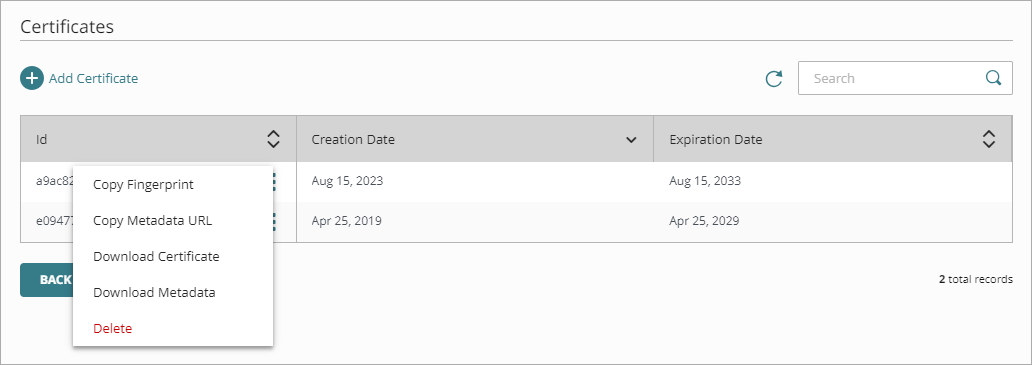
- Cohesity SSO only accepts .PEM certificate files. After you download the AuthPoint certificate, you must rename the certificate and change the file extension from .CER to .PEM.
- Log in to Cohesity Helios as an administrator.
- Select Settings > Access Management.
- Select the Single Sign-On tab.

- Click Configure SSO.
The Configure SSO page opens. - In the SSO Domain text box, type your domain. In our example, we type watchguard.com.
To redirect a user to AuthPoint when they log in, the user must type append the SSO domain to their user name. In our example, this would be [email protected].
Because Helios supports multiple identity providers, this value must be a unique string (usually company domain).
- In the SSO Provider text box, type AuthPoint.
- Open the AuthPoint metadata file you downloaded in Step 5 and find the SingleSignOnService Location and entityID values.
- In the Single Sign-On URL text box, paste the SingleSignOnService Location value from the AuthPoint metadata file.
- In the Provider Issure ID text box, paste the entityID value from the AuthPoint metadata file.
- Below X.509 Certificate, click Select File and upload the AuthPoit certificate file that downloaded and renamed in Steps 5-6. Cohesity SSO only accepts .PEM certificate files.
- (Optional) From the Default Role for all SSO Users drop-down list, select a default role for the SSO user. In our example, we select Viewer.
- Select Access to All Clusters.
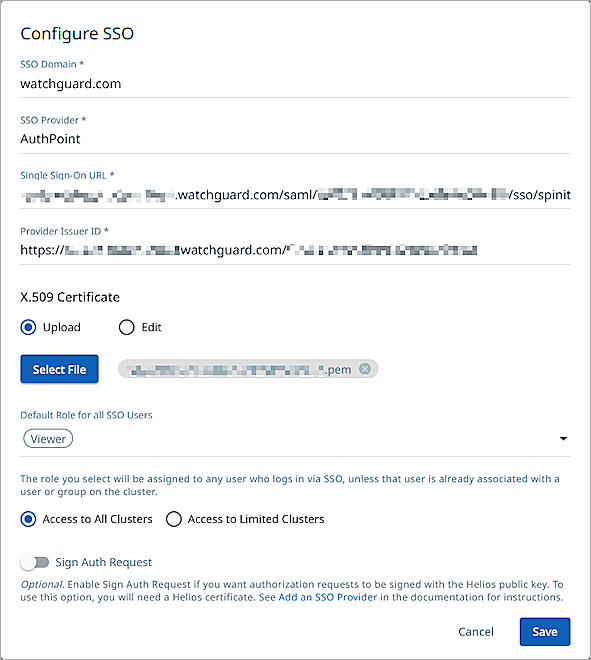
- Click Save.
Add an SSO Group
- From the left navigation menu, select Settings > Access Management.
- Click Add User.
The Add user page opens. - Select Add SSO User & Groups.
- In the SSO Domain drop-down list, select the SSO Domain you specified in the previous section.
- Leave the SSO User text box empty.
- In the SSO Groups text box, type the name(s) of your user groups. In our example, type cohesity_group.
The group names in Cohesity Helios must exactly match the group names in AuthPoint. This is case-sensitive.
- From the Roles drop-down list, select any role or multiple roles. In our example, select Viewer.
- From the Accessible Systems drop-down list, select All Systems.
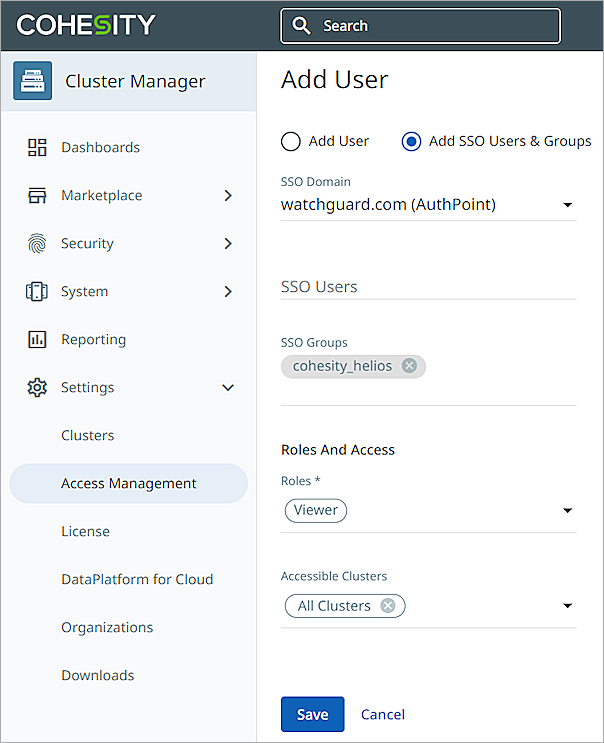
- Click Save.
Configure AuthPoint
Before AuthPoint can receive authentication requests from Cohesity Helios, you must add a SAML resource in AuthPoint. You must also create an authentication policy for the Cohesity Helios resource to determine which users can authenticate and log in to Cohesity Helios and which authentication methods they can use (Push, QR code, and OTP).
Add a SAML Resource in AuthPoint
From the AuthPoint management UI:
- From the navigation menu, select Resources.
Click Add Resource.
The Add Resource page opens.

- From the Type drop-down list, select SAML.
Additional fields appear.

- On the SAML page, in the Name text box, type a name for this resource.
- From the Application Type drop-down list, select Others.
- In the Service Provider Entity ID text box, type https://helios.cohesity.com/v2/mcm/idp/authenticate.
- In the Assertion Consumer Service text box, type https://helios.cohesity.com/v2/mcm/idp/authenticate.
- Leave the Logout URL text box empty.
- In the Signature Method drop-down list, select SHA-256.
- From the AuthPoint Certificate drop-down list, select the certificate to associate with your resource. This must be the same certificate that you downloaded the metadata for in the previous section.
- Add custom attributes for groups and email.
- In the Custom Attributes section, click Add Attributes.
The Add Attribute window opens. - In the Attribute Name text box, type Groups. This value is case-sensitive.
- From the Get Value From drop-down list, select User groups.
- Click Save.
The Add Attribute window closes. - In the Custom Attributes section, click Add Attributes.
The Add Attribute window opens. - In the Attribute Name text box, type Email. This value is case-sensitive.
- From the Get Value From drop-down list, select User email.
- Click Save.
The Add Attribute window closes.
- In the Custom Attributes section, click Add Attributes.

- Click Save.
AuthPoint saves your resource and the Resources page opens.
Add a Group in AuthPoint
You must have at least one user group in AuthPoint to configure MFA. If you already have a group, you do not have to add another group.
Your AuthPoint group names must exactly match the names of your user groups in Cohesity Helios.
To add a group to AuthPoint:
- From the navigation menu, select Groups.
- Click Add Group.
The New Group page appears.

- In the Name text box, type a descriptive name for the group.
- (Optional) In the Description text box, type a description of the group.
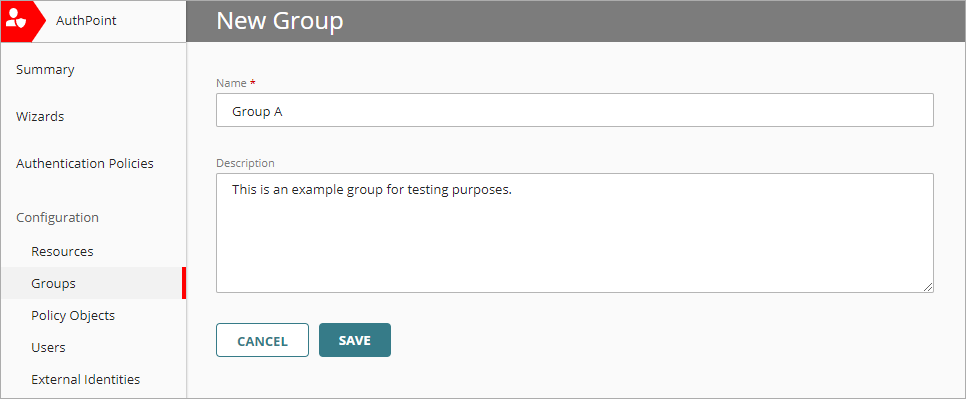
- Click Save.
Your group is listed on the Groups page.
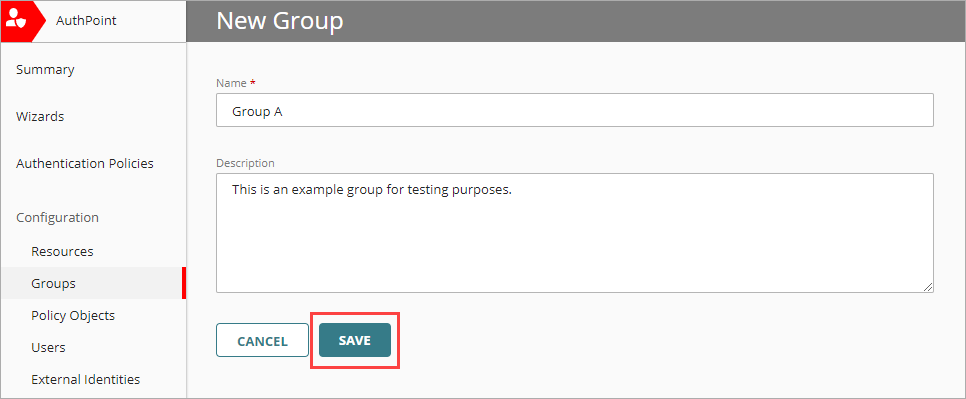
Add an Authentication Policy to AuthPoint
Authentication policies specify which resources users can authenticate to and which authentication methods they can use (Push, QR code, and OTP).
You must have at least one authentication policy in AuthPoint that includes the Cohesity Helios resource. If you already have authentication policies, you do not have to create a new authentication policy. You can add this resource to your existing authentication policies.
Users that do not have an authentication policy for a specific resource cannot authenticate to log in to that resource.
To configure an authentication policy:
- From the navigation menu, select Authentication Policies.
- Click Add Policy.

- Type a name for this policy.
- From the Select the authentication options drop-down list, select Authentication options and select which authentication options users can choose from when they authenticate.
For SAML resources, if you select more than one authentication option, users must select one of the available options when they authenticate. For example, if you select OTP and Push, users can choose to type their OTP or approve a push to authenticate. You cannot require that they do both.
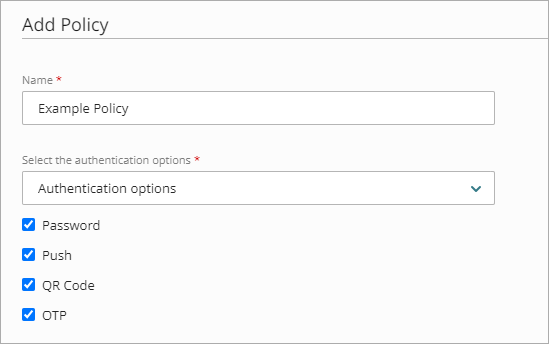
- Select which groups this policy applies to. You can select more than one group. To configure this policy to apply to all groups, select All Groups.
- Select the resource that you created in the previous section. If you want this policy to apply to additional resources, select each resource this policy applies to. To configure this policy to apply to all resources, select All Resources.
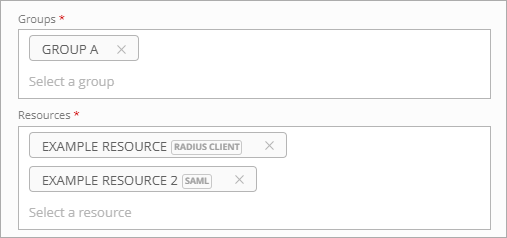
-
(Optional) If you have configured policy objects such as a Network Location, select which policy objects apply to this policy. When you add a policy object to a policy, the policy only applies to user authentications that are the same as the conditions of the policy objects. For example, if you add a Network Location to a policy, the policy only applies to user authentications that come from that Network Location. Users who only have a policy that includes a Network Location do not get access to the resource when they authenticate outside of that Network Location (because they do not have a policy that applies, not because authentication is denied).
If you configure policy objects, we recommend that you create a second policy for the same groups and resources without the policy objects. The policy with the policy objects should have a higher priority.
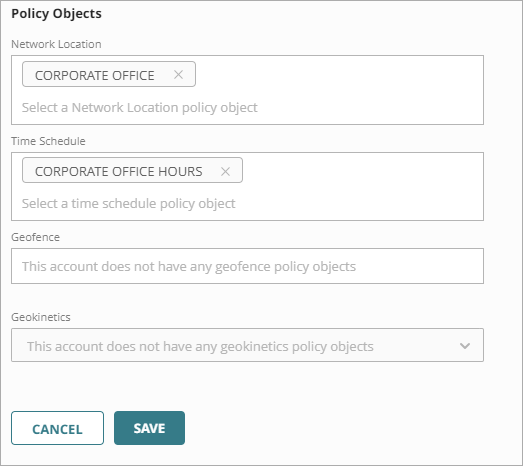
- Click Save.
Your policy is created and added to the end of the policy list.When you create a new policy, we recommend that you review the order of your policies. AuthPoint always adds new policies to the end of the policy list.
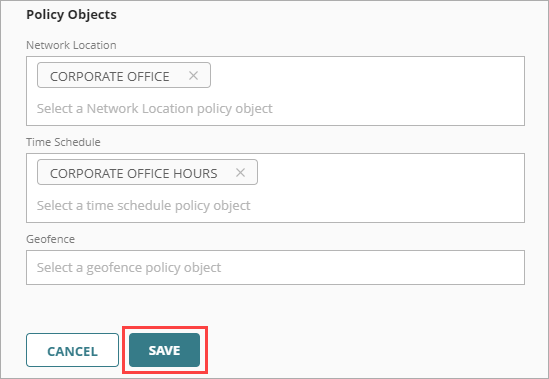
Add Users to AuthPoint
Before you assign users to a group, you must add the users to AuthPoint. There are two ways to add AuthPoint user accounts:
- Sync users from an external user database
- Add local AuthPoint users
Each user must be a member of a group. You must add at least one group before you can add users to AuthPoint.
To import users from Active Directory, Microsoft Entra ID, or an LDAP database, you must add an external identity in the AuthPoint management UI. External identities connect to user databases to get user account information and validate passwords.
- To sync users from Active Directory or an LDAP database, you must add an LDAP external identity
- To sync users from Microsoft Entra ID, you must add a Microsoft Entra ID external identity
When you sync users from an external user database, you can sync any number of users and they are all added to AuthPoint at one time. Users synced from an external user database use the password defined for their user account as their AuthPoint password.
To learn how to sync users, go to Sync Users from Active Directory or LDAP and Sync Users from Azure Active Directory.
You can create local AuthPoint users on the Users page in the AuthPoint management UI. Because you can create only one user at a time, you most commonly do this when you want to create test users or to add only a small number of users.
Unlike users synced from an external user database, local AuthPoint users define and manage their own AuthPoint password. When you add a local user account, the user receives an email that prompts them to set their password.
To learn how to add local AuthPoint user accounts, go to Add Local AuthPoint Users.
Test the Integration
To test AuthPoint MFA with Cohesity Helios, you can authenticate with a mobile token on your mobile device. For SAML resources, you can choose any method (push, QR code, or one-time password).
In this example, we show the push authentication method (users receive a push notification in the mobile app that they must approve to authenticate).
- In a web browser, go to the Cohesity Helios URL.
- Type your user name, formatted as username@SSO_Domain. In our example, our domain is watchguard.com and our user name is jdoe, so we type [email protected].
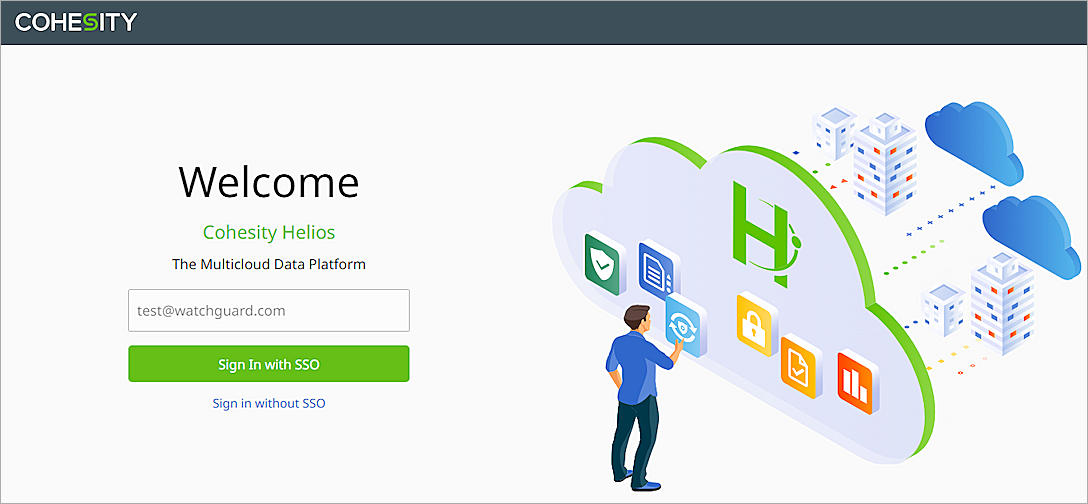
- Click Sign in with SSO.
- Type your email address or AuthPoint user name. Click Next.
- In the Password text box, type your password.
- For the authentication method, select Send Push.
- Approve the authentication request that is sent to your mobile device.
You are logged in to Cohesity Helios.